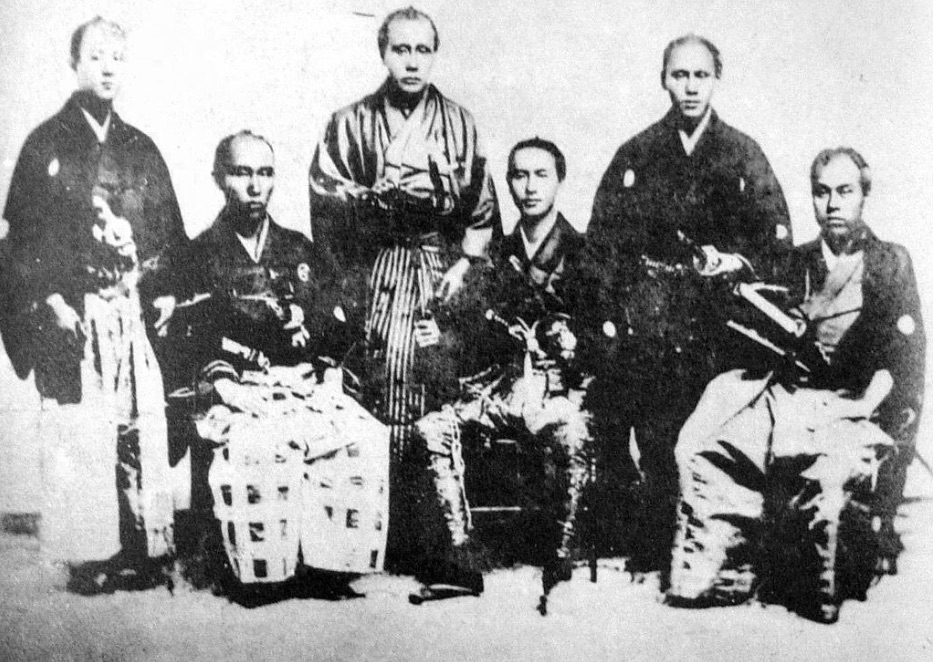 The Japanese Embassy’s Escorts from the Steamship Kanrin Maru in 1860. Image via Wikipedia
The Japanese Embassy’s Escorts from the Steamship Kanrin Maru in 1860. Image via Wikipedia
In 1853 US Commodore Matthew Perry steamed his way into Tokyo Bay (then called Edo Bay) and pretty much bullied the Japanese into ending 250 years of global isolation. Seven years later, the first Japanese delegation of 80 Samurai diplomats sent from the Tokugawa Shogunate set sail for a three month tour of the United States. While the rest of the country tried to put on their Sunday best for the Japanese, it was New York City that really showed these guys how to party.
On June 16, 1860, the delegation boarded a steamship leaving Philadelphia and by 1:30PM heard salute shots being fired from Governors Island and the Battery. Once docked at Pier 1, 5,000 New York military men received the delegation and brought them along their route from the Battery to their headquarters at the Metropolitan Hotel. It was reported that hundreds of thousands of New Yorkers lined the streets to catch their first glimpse of the Samurai visitors.
New York used the pursestrings of the City Council and the taxpayers to transform the opulent Metropolitan Hotel into the first Japanese Embassy. The delegation was given 74 rooms which were all refurbished to accommodate the grandiose scale of the occasion. Over each room door was the name of an American state translated into Japanese along with a Japanese motto of welcome. Each bed was outfitted with ornate bedspreads made of Chinese silk (manufactured in Calcutta) and the ceilings were all re-frescoed with “Japanese scenes.”
The real magic happened on June 25th when New York City hosted one of the most lavish parties to date simply called “The Japanese Ball.” The New York Times article describing the event (which reads like something from a Henry James novel) opens with the following: “The memory of the night of June 25, 1860 will long shine like a rose-pink lantern, or an apothecary’s window, in the civic annals of New York.”
The ball took up all the dining rooms and the famed Niblo Theatre extending out to both gardens and into a labyrinth of hallways, parlors and side rooms. Every room was ornamented with Japanese and American flags and flowers as a symbol of the two countries new-found friendship. Although the Times did not report on the specifics of the dinner itself, they assured their readers that the service and the supper were carried out admirably in the crowd of 20,000 strong.
After dinner and a “polite reception of the Committee on the part of the Embassy,” the Japanese delegations and officials from the New York Chamber of Commerce sat down with their interpreters to talk turkey. The Chamber of Commerce presented the delegation with seven questions involving the Japanese government’s roll in regulating the exportation of gold, silver, coal and copper. The Japanese returned with answers involving tea and rice including my favorite translated statement: “That in Japan, their preference was for Green Teas, and that they had some doubt whether the kinds of tea grown in Japan would suit the American Market.” In response, one of the Chamber of Commerce delegates said he received a sample of Japanese green tea and liked it. The Japanese ambassadors were pleased and thus began New York’s obsession with green tea lattes (I kid).
Once all the pesky business-talk was out of the way and topped with a “cordial shaking of hands,” the ball turned into a Victorian era dance party, conservative to be sure, but as the Times so aptly pointed out: “Niphon dancing the polka with New Amsterdam—the idea is revolution itself.”
Speaking of polka, after the highly publicized ball, New York suffered from a bad case of Japanese mania. The object of everyone’s eye was the delegation’s youngest member, Tateishi Onojiro or affectionately known to ethnocentric Victorian New Yorker’s as Tommy. Move over Beliebers, Onojiro was so popular there was a “Tommy Polka” written for him. And to demonstrate that we’ve all become a little more open-minded these days, here are the lyrics to said polka:
“Wives and maids by scores are flocking
Round that charming, little man,
Known as Tommy, witty Tommy,
Yellow Tommy, from Japan.”
Go ahead and take a listen to the orchestral version…. without the culturally insensitive lyrics.
Next, check out the 10 Most Architecturally Extraordinary Consulates, Embassies, and Foreign-owned Buildings in NYC.





